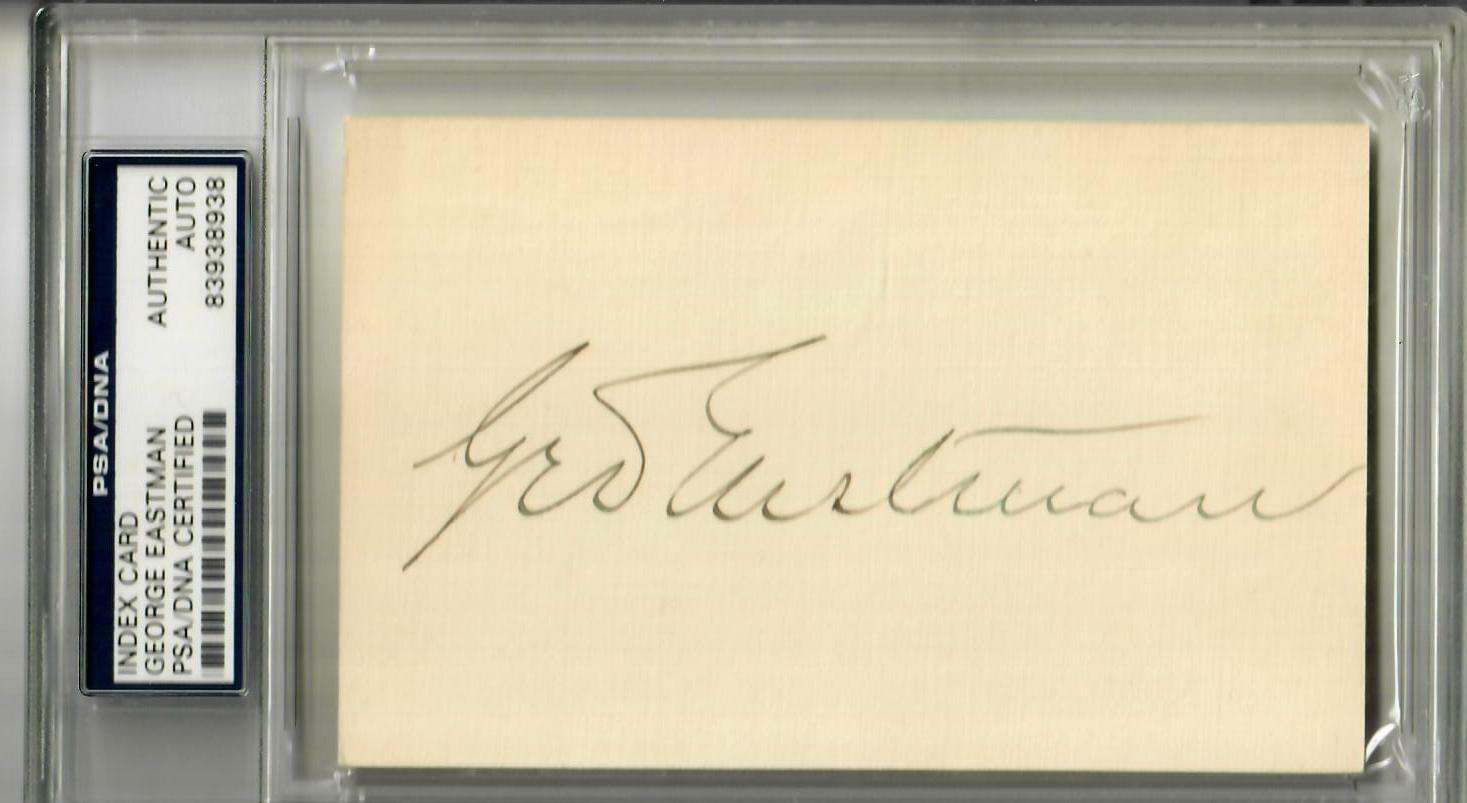-40%
RARE! "Kodak Founder" George Eastman Hand Signed 3X5 Card PSA/DNA COA
$ 1774.07
- Description
- Size Guide
Description
Official PayPal Conversion RatesAdd
Currency Converter
To Your Items
Up for auction
RARE! "Kodak Founder" George Eastman Hand Signed 3X5 Card
.
This item is authenticated By Collectors Universe (PSA/DNA) and comes with their certificate of authenticity and hologram affixed and a second COA from Signature Auctions.
ES-1624
George Eastman
(July 12, 1854 – March 14, 1932) was an American entrepreneur who founded the
Eastman Kodak
Company and helped to bring the
photographic
use of
roll film
into the mainstream. Roll film was also the basis for the invention of motion picture
film stock
in 1888 by filmmakers
Eadweard Muybridge
and
Louis Le Prince
, and a few years later by their followers
Léon Bouly
,
William Kennedy Dickson
,
Thomas Edison
, the
Lumière Brothers
, and
Georges Méliès
. He was a major
philanthropist
, establishing the
Eastman School of Music
,
Rochester Philharmonic Orchestra
, and schools of dentistry and medicine at the
University of Rochester
and in London
Eastman Dental Hospital
; contributing to the
Rochester Institute of Technology
(RIT) and the construction of several buildings at the second campus of
Massachusetts Institute of Technology
(MIT) on the Charles River. In addition, he made major donations to
Tuskegee University
and
Hampton University
,
historically black universities
in the South. With interests in improving health, he provided funds for clinics in London and other European cities to serve low-income residents. In his final two years, Eastman was in intense pain caused by a disorder affecting his spine. On March 14, 1932, Eastman shot himself in the heart, leaving a note which read, "To my friends: my work is done. Why wait?" The
George Eastman Museum
has been designated a
National Historic Landmark
. Eastman is the only person represented by two stars (both in film stars) in the
Hollywood Walk of Fame
, one in North side of the 6800 block of
Hollywood Boulevard
and the other one in West side of the 1700 block of
Vine Street
, recognizing the same achievement, that he developed,
bromide paper
, which became a standard of the film industry. astman was born in
Waterville, New York
as the youngest child of George Washington Eastman and Maria Eastman (
née
Kilbourn), at the 10-acre (4.0 ha) farm which his parents had bought in 1849. He had two older sisters, Ellen Maria and Katie He was largely self-educated, although he attended a private school in Rochester after the age of eight. In the early 1840s his father had started a business school, the Eastman Commercial College in
Rochester, New York
. The city became one of the first "boomtowns" in the United States, based on rapid industrialization. As his father's health started deteriorating, the family gave up the farm and moved to Rochester in 1860. His father died of a brain disorder on April 27th, 1862. To survive and afford George's schooling, his mother took in boarders.
The second daughter, Katie, had contracted
polio
when young and died in late 1870 when George was 15 years old. The young George left school early and started working to help support the family. As Eastman began to have success with his photography business, he vowed to repay his mother for the hardships she had endured in raising him. n 1884, Eastman patented the first film in roll form to prove practicable; he had been tinkering at home to develop it. In 1888, he developed the Kodak camera ("Kodak" being a word Eastman created), which was the first camera designed to use roll film. He coined the advertising slogan, "You press the button, we do the rest" which quickly became popular among customers. In 1889 he first offered film stock, and by 1896 became the leading supplier of film stock internationally. He incorporated his company under the name Eastman Kodak, in 1892. As film stock became standardized, Eastman continued to lead in innovations. Refinements in colored film stock continued after his death. In an era of growing
trade union
activities, Eastman sought to counter the union movement by devising worker benefit programs, including, in 1910, the establishment of a profit-sharing program for all employees. Considered to be a progressive leader for the times, Eastman promoted Florence McAnaney to be head of the personnel department. She was one of the first women to hold an executive position in a major U.S. company.
View more great items










